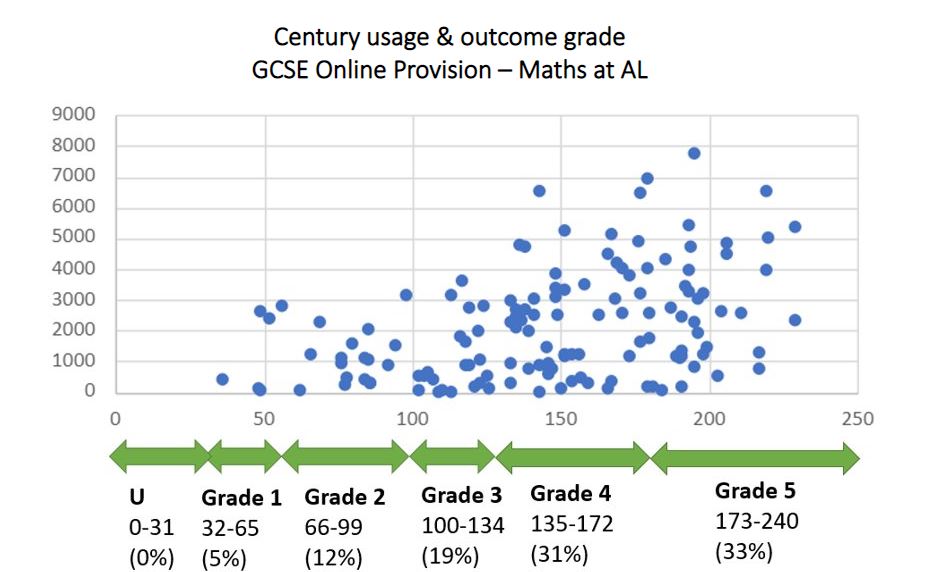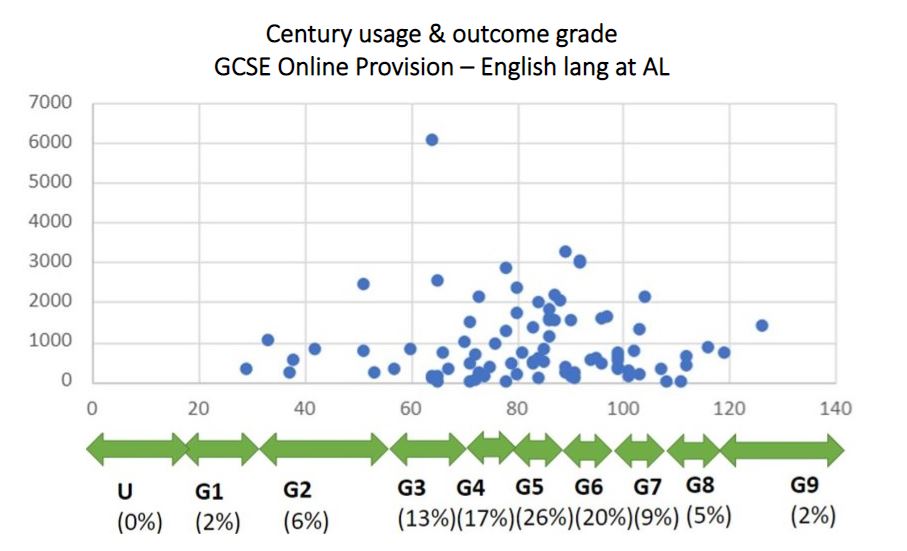
While much of the discussion around AI is focused on its potential, in reality AI is already making an impact on the education sector. In this series of case studies, therefore, we aim to share insights into how universities and colleges are benefiting from some of the more established AI resources that are available.
How Further Education Colleges are benefiting from CENTURY
Award winning platform, CENTURY, is used widely through the further education sector, with over 60% of colleges in England using the platform. Through its use of artificial intelligence, the platform personalises learning journeys for individual users by selecting the topics they most need to learn, and presenting learning material in the form they will find most useful. CENTURY also reduces educators’ workloads through automated marking, data analysis and gap finding, and due to its pre-loaded bank of learning resources.
Aiming to gain a strong understanding of how Jisc’s further education members can gain from CENTURY, we spoke to three colleges who are already experiencing its benefits. Staff and learners from St Helens College, Activate Learning and Calderdale College kindly shared their time and insights with us, to help create the following case studies in which we explore the platform’s benefits and use cases for further education settings.
St Helens College, supporting independent learning
We spoke to: Andrea Beatty, Head of School for English and Maths at St Helens College
General impact: St Helens College uses CENTURY to support learners in English and maths, for both GCSE and functional skills qualifications.
While CENTURY is incorporated into lessons at St Helens College, its primary use case has been in supporting independent learning. As Andrea noted, out-of-lesson usage has been especially high for adult learners, who are keen to make use of digital resources to extend their provision beyond the classroom.
Andrea explained that the pre-loaded learning material for relevant courses is broken down into short, snappy micro-lessons called ‘nuggets’. After learners complete each nugget, they take a quick assessment so that they can test and extend their understanding. This also allows the platform to measure how well they have grasped the topic in question.
Deeper insights: We spoke to two adult learners from the college who had used CENTURY to help them with both English and maths. Each of the learners confirmed that CENTURY was a valuable resource for independent learning and had helped them to consolidate understanding and make additional progress. Both learners spoke positively about the quality of the learning material available. One learner praised how well mathematical concepts and techniques were explained in both the slides and videos. The other – a learner for whom English was not their first language – described how the nuggets for English topics helped them to improve their grammar through targeted practice.
The learners were also positive about the platform’s user friendliness, though it transpired that they had different preferences on how to use it. One of the learners preferred to make their own choices on what topics they wanted to study and then search for them in CENTURY’s library, whereas the other was keen to use the platform’s AI recommendations where appropriate, so that they could be guided on what they needed to learn. For the former learner, CENTURY’s AI capability was a bonus: good quality content took priority over personalisation. For the latter, the AI functionality allowed them to work through a large curriculum optimally – which meant not spending too much time on topics that had already been mastered, but also working up to those that were more challenging.
Final thoughts: Andrea’s feedback was highly encouraging. Indeed, she even described CENTURY as the best learning platform the college had used, noting that its use of automated marking and the ease of setting work meant that CENTURY was genuinely reducing teachers’ workloads. One point she also made is that learners and teachers would benefit from CENTURY being available as an app, rather than just being accessible via browser.
Activate Learning, engaging distance-learners
We spoke to: James Clark, Director of English and Maths, and Fumiko Pescott, an online learning specialist.
General impact: One of Activate Learnings’ key cohorts is their online students, who are, for the most part, distance learners. While this mode of learning can pose challenges, Activate Learning has been able to cut through these thanks, in part, to CENTURY.
The platform’s diagnostics, for instance, allow teachers to factor individual and group needs into their long-term planning, while weekly assessments turn tracking progress and providing as-needed support into a relatively simple task. Daily challenges, whereby learners complete a specified set of nuggets on CENTURY, help them to both retain knowledge and prepare for new topics. Meanwhile, CENTURY has been credited with boosting learners’ confidence and engagement with learning thanks to its ability to identify gaps in knowledge which could inhibit progress.
Learners who attend in-person at Activate Learning are also benefiting from CENTURY. Here, however, we focus on gaining an in-depth understanding of the use case for online learners.
Deeper insights: James and Fumiko shared with us the data they had collected on CENTURY’s impact and its perception amongst distance-learning learners.
Their survey results showed decisively that distance-learning learners valued CENTURY. In response to the question: ‘Do you feel that CENTURY helped you to improve your skills in your subjects?’ learners gave an average score of 4.56 out of 5. For the question ‘Do you feel that CENTURY helped you to improve your confidence?’, the average score was 4.5. Notably, 92% of learners found CENTURY useful for revision.
Analysing usage, James and Fumiko found that only 1% of learners did not use CENTURY on a weekly basis, whereas 30% of learners spent more than 3 hours on CENTURY per week – with nearly half of those spending more than 5 hours.
They also collected data to assess whether CENTURY usage had an impact on learners’ grades.


These graphs show the relationship between Activate Learning learners’ GCSE grades (on the x-axis) and questions answered on CENTURY (on the y-axis). Each dot represents a learner at Activate Learning.
Activate Learning has been exploring the relationship between time spent learning on CENTURY and performance in both English and maths. The strongest apparent relationship is between maths grades and CENTURY usage and has prompted further investigation of the direct impacts of CENTURY in this area.
The differences between the graphs for English and maths chimed with James and Fumiko’s observations of how their students used CENTURY differently in these subjects. While the platform can support all aspects of learning for maths, with English CENTURY is more focused on supporting comprehension, e.g. for literary concepts or grammatical rules. And while this has resulted in the platform not being directly used to help learners practise their writing, James and Fumiko did point out that CENTURY can support writing indirectly. As per the flipped learning model, setting learners nuggets that teach the theory of a topic before a live session, means that more time during the session can be spent getting learners to apply – through writing – the knowledge they already have.
Final thoughts: Given the national centre for AI’s focus, we were keen to find out how much of CENTURY’s value stemmed from its use of artificial intelligence, and how much was down to other aspects of the product. This question had also interested James and Fumiko, who had asked CENTURY Tech to analyse usage data, which had revealed that 27% of the time, learners were learning topics that had been recommended to them by CENTURY’s AI. And while this is not the majority of instances – perhaps to be expected as learners are often set specific tasks based on what’s being covered in their lessons – it does suggest a clear trend of learners making use of AI’s ability to identify the topics they most need support with.
Calderdale College, tracking learner progress
We spoke to: Richard Greenwood, Curriculum Area Leader for English, Maths and ESOL
General impact: Calderdale College first turned to CENTURY during the pandemic, to enable effective remote learning and to keep teachers informed of learner progress. Three years on, CENTURY remains a staple of the college’s provision in English and maths for GCSE and functional skills courses.
Learners at Calderdale College largely use CENTURY for homework/extension activities with the aim of helping them to revise or practise a topic. This, Richard explained, is primarily because learners tend to prefer a teacher to introduce them to a topic first, so that they can grasp the underlying ideas before applying them independently. Learners also go back and study more foundational topics, where needed. Richard praises the fact that the content on CENTURY goes back to the fundamentals of a topic, allowing learners to get the basics right in their own time.
Deeper insights: Speaking to Richard, we learnt more about how CENTURY provides oversight of learner performance. In addition to the learner-facing side of the platform, teachers can also use CENTURY to set work and view learner progress via their own dashboard. Every time a learner completes a nugget or answers a question, data is captured and presented to their teachers in an easy-to-grasp way.
One aspect of the dashboard that was universally popular amongst teachers at Calderdale College was the ‘effort-outcome square’, which helps teachers identify four categories of learners:
- Those who spend a good amount of time on a topic and perform well (and may be deserving of praise)
- Those who spend less time on a topic but still perform well (and might want to focus on more difficult material)
- Those who spend less time on a topic and underperform (and perhaps should be pushed to put in more effort)
- And those who spend a good amount of time on a topic but still underperform (and are candidates for more targeted teaching support).
Richard noted that his colleagues often consult this graphic to get a snapshot of the whole class, and to work out what support each learner needs. Armed with this bird’s-eye view, teachers can dig deeper into the data and get detailed information on which topics learners found challenging and where they were excelling.
As Richard also explained, while colleges often use online platforms to perform standardised diagnostics on whole cohorts, CENTURY’s particular strength is in helping to track learners’ progress live, dynamically informing teachers of learners’ strengths and gaps in knowledge, thus enabling made-to-measure planning for both classes and individual learners.
Final thoughts: Richard also commended CENTURY’s user interface and emphasised that CENTURY Tech are particularly responsive and good to work with. In one case, CENTURY Tech developed an initial assessment for functional skills maths (which could be automarked on the platform) after Calderdale College requested such a tool.
Thoughts and reflections
From what we heard, it is clear that learners and teachers value CENTURY, and that the platform has many strengths. It comes with learning material that is extensive and of a high quality. It provides teachers with detailed, actionable insights into learners’ needs. And its AI recommendations help to make sure learners can focus on the topics they need most support with.
The platform itself was seen as slick and easy to use – and it will be interesting to see whether it becomes available as an app in due course.
Next steps
We have seen how CENTURY is having a strong positive impact on the three colleges we have spoken to.
If you would like to find out more about CENTURY by talking to one of the colleges, then please contact ai@jisc.ac.uk.
Alternatively, you can contact CENTURY by going to www.century.tech/fe or by emailing info@century.tech.
To find out more about other exciting uses of AI in tertiary education, do check out Jisc’s AI Map. This is a great place to start to explore the rich variety of ways colleges and universities are already benefiting from AI.
And please do keep in touch with the national centre for AI by joining our mailing list.
Find out more by visiting our Artificial Intelligence page to view publications and resources, join us for events and discover what AI has to offer through our range of interactive online demos.
For regular updates from the team sign up to our mailing list.
Get in touch with the team directly at AI@jisc.ac.uk
